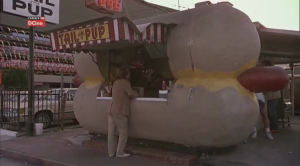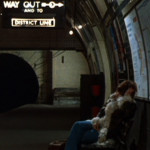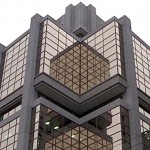The Psychotronic Tourist: BODY DOUBLE (1984)
Welcome to the very first instalment of The Psychotronic Tourist! Originally written for Fangoria’s website, I decided to kick off the column by visiting some of the key locations from one of De Palma’s most excessive pictures, the oft-maligned VERTIGO/REAR WINDOW riff BODY DOUBLE (1984). Say what you will about the phallocentric nature of the film’s imagery and mental space, but BODY DOUBLE remains not only a lush, enthralling mystery set in the seedy underbelly of the movie biz, but also a virtual tour through many of Los Angeles’ most historic landmarks, some of which are sadly no longer with us. Upon a recent visit to L.A. I teamed up with Severin Films’ David Gregory, who took me around on a whirlwind day-trip through the titillating topography of vintage De Palma.
 TAIL O’THE PUP – 311 N. La Cienaga (now closed)
TAIL O’THE PUP – 311 N. La Cienaga (now closed)
On his way home after a weird day on set in B-picture “Vampire’s Kiss” – where a long-repressed anxiety concerning closed-in spaces is suddenly reawakened in a coffin sequence – actor Jake Scully (Craig Wasson, the diminutive dick-flapping star of GHOST STORY) stops in at the iconic hot dog-shaped food stand for some take-out. The Pup was built in 1946 and one of the longest-surviving examples of programmatic or “novelty” architecture, meant to emulate the image of the product it sold as an eye-catching appeal to increasing car culture (and which also guaranteed it a place in every L.A. establishing montage). Originally installed at 311 N. La Cienaga, built by architect Milton Black (out of chicken wire and stucco) for the dance duo of Veloz and Yolanda, it was bought in 1971 by Eddie Blake, whose family still owns it. A year after BODY DOUBLE’s premiere, it had been moved to 329 North San Vicente Boulevard a few yards away, but was evicted from that location in 2005 to make way for a condo development that has never materialized. The hot dog homestead remains in a warehouse in Torrance, CA while the Blakes renegotiate a new spot.

 JAKE SCULLY’S HOUSE – 320B N. Sycamore Ave
JAKE SCULLY’S HOUSE – 320B N. Sycamore Ave
Arriving home with a meal for two, Jake walks in on his girlfriend Carol (FANGO fave Barbara Crampton in her big-screen debut) “glowingly” romper-rooming with another man, leaving Jake dejected and essentially homeless. The house itself is an example of the Spanish colonial revival that was embraced as the “indigenous style” of California as a result of the 1915-1917 San Diego Panama-California Exposition to celebrate the opening of the Panama Canal. Built in the mid-1920s, cinematically the style would come to reflect what film historian Thom Anderson refers to as the “petit-bourgouis good taste” of a heady roster of noir film characters, ranging from DOUBLE INDEMNITY to KISS ME DEADLY – a genre heavily referenced in BODY DOUBLE. Still, Jake is a struggling actor, and this is no hillside hideaway – this particular house remains, as it was in BODY DOUBLE, a multi-unit dwelling, with its apartments these days going for close to $2K a month .


 BARNEY’S BEANERY – 8447 Santa Monica Boulevard
BARNEY’S BEANERY – 8447 Santa Monica Boulevard
After a long stint in soberville, Jake jumps off the wagon at Barney’s with a two-fister of “Jack Daniels, neat” while his bartender friend Doug obliges disapprovingly. Some of BODY DOUBLE’s locations are more storied than others, and Barney’s Beanery’s is one of the most colourful. It’s been a fixture of music and movie lore ever since it opened in 1927; Jean Harlow picked up men here, Janis Joplin ate her last meal there, and it’s where Jim Morrison infamously urinated against the wooden bar, to be ejected shortly thereafter (an incident later depicted in in Oliver Stone’s THE DOORS). From Clark Gable to Quentin Tarantino, Barney’s has been a regular stoop for a revolving queue of entertainment biz luminaries. Located on the eastern edge of West Hollywood’s “Boys Town” it was also contentiously host to a longstanding sign (mounted in the 1940s by the original owner) stating “Fagots [sic] Stay Out”; the year BODY DOUBLE came out, West Hollywood became its own city, and its first mayor, the lesbian Valerie Terrigno, led a campaign to remove the sign, resulting in a public apology from Barney’s. But Barney’s is known for more than just controversy – its name stems from the original owner’s Depression-era habit of giving free beans and beer to unemployed travellers in exchange for their license plates, which still adorn the walls to this day.

 HOLLYWOOD TOWER – 6200 Franklin Ave.
HOLLYWOOD TOWER – 6200 Franklin Ave.
With Jake’s sorrows sufficiently doused at Barney’s, Doug offers him a place to crash on his beaten brown sofa at the hulking Hollywood Tower Apartments, a French Normandy style perched ominously on a hillside that now butts up against the Hollywood Freeway. Built in 1929 with investment money from actor George Raft, The Hollywood Tower became a popular residence for many Golden Age-era movie stars (most famously Humphrey Bogart), originally with 50 apartments (now 198). By the time BODY DOUBLE rolled around, the place had fallen into disrepair and was home to mostly senior citizens, which explains how a Barney’s bartender would be able to afford a pad in the former glamour-hub. The building has since been rejuvenated and has attempted to renew its image as culturally happenin’ with rooftop concerts and fashion shows, and in 1994 became the inspiration for Disney’s Twilight Zone Tower of Terror thrill ride (and subsequent movie). But run down or not, in BODY DOUBLE it still has one of the city’s most classic views of the Hollywood heartland, as illustrated when Jake poses before the window, framing a beautiful image of one of my fave L.A. landmarks, the Capitol Records building.

 THE FARMER’S MARKET – 6333 West 3rd Street
THE FARMER’S MARKET – 6333 West 3rd Street
The next morning, Jake is perusing the classifieds in the Drama-Logue – a then-weekly trade paper (assimilated by the competing Back Stage West mag in 1998) which served as the unofficial newsletter of the performing arts scene – over a cuppa Joe at The Farmer’s Market at 3rd and Fairfax. An indoor/outdoor collection of artisan stalls, fresh produce and specialty gastronomical treats first opened in 1934, The Farmer’s Market (a block north of The Miracle Mile, site of one of my other favourite 80s films) remains a popular hangout for actors prepping for auditions, situated as it is right next to the CBS Television studio.
 THE CALLBOARD THEATRE – 8451 Melrose Place (building no longer there)
THE CALLBOARD THEATRE – 8451 Melrose Place (building no longer there)
Jake circles an ad in the Drama-Logue calling for all roles in a travelling Shakespeare Festival, which is holding auditions at The Cascade Theatre at 1143 Walnut St – in actuality The Callboard Theatre on Melrose (you can see its name right on the exterior sign), a small equity-waiver (99 seat) venue that was well-established by the time BODY DOUBLE was filmed –in his memoirs Steve Martin writes that one of his earliest memories is of seeing his father – who worked there – onstage in a bit part in the early 50s, and Rosanna Arquette’s acting debut was in a version of Ovid’s Metamorphosis, staged there in 1977. The venue was running strong until at least the early 90s, but surprisingly little documentation remains on its history. A carpet store currently resides at the same address but the building itself bears no resemblance to the one in DePalma’s film (as such, it’s not on the map).

 THE CHEMOSPHERE HOUSE – 7776 Torreyson Drive
THE CHEMOSPHERE HOUSE – 7776 Torreyson Drive
Jake thinks he gets a lucky break when a new acquaintance met outside The Callboard, fellow actor Sam Bouchard (Gregg Henry of Jeff Lieberman’s JUST BEFORE DAWN), passes on his house-sitting gig to the homeless Jake. The job detail: hang out in one of the world’s most legendary houses, and make sure to water the plants every day after 6pm. Among the many LA landmarks in DePalma’s film, this one is hands-down the most iconic. Designed by Frank Lloyd Wright disciple John Lautner in 1960, the modernist unipedal spaceship structure corroborates film historian Thom Anderson’s assertion in his film-essay LOS ANGELES PLAYS ITSELF that Los Angeles’ modern architecture is associated, through the movies, with villainy – often serving as the domiciles of criminal types. The Chemosphere was first seen onscreen in an episode of THE OUTER LIMITS and would serve as the direct inspiration for criminal mastermind Eric Knox’ pad in CHARLIE’S ANGELS (2000). The Chemosphere isn’t the only Lautner house subject to suspect associations: THE BIG LEBOWSKI’s drug baron Jackie Trehorn lives at the Lautner-designed Sheats Goldstein Residence (built 1961-1963), and the Garcia House in LETHAL WEAPON 2 (a longtime residence of Vincent Gallo) collapses when Mel Gibson literally pulls the entire hillside house down with his pickup truck – itself an audacious statement against Lautner’s competence as an architect. And while Lautner was known for ostentatious design, the tacky interior of the house in BODY DOUBLE is a set, and its funicular railway is also remodelled on a soundstage. The house is on the east side of the Hollywood Hills, and hard to see from the road as you drive up – it’s only when you give up at a dead end and start back that you see it looming over the trees. The house is currently owned by Benedikt Taschen, of the German Taschen publishing house (who gives us all those breathtaking art books), but only after it sat on the market for so long that its un-sellability was even parodied on THE SIMPSONS. (Note: Private residence, please stay off the property)
 GLORIA REVELLE’S HOUSE – 1405 Miller Drive
GLORIA REVELLE’S HOUSE – 1405 Miller Drive
Of the many perks offered up by a stay at the Chemosphere – aside the sauna-jacuzzi combo and endless porn channels – is its direct line via telescope through the bedroom windows of a woman in a house who likes to perform a nightly routine of sensual self-service, later revealed to be one Gloria Revelle (a voice-dubbed Deborah Shelton, whose only screen role by that time was in the horror film BLOODTIDE). Gloria’s large but bland modern white house sits atop an opposite hill (in actuality on the other side of the canyon, and not walking distance as the film supposes), sequestered by a long drive down to the road from which it can’t be clearly seen (This is a private residence, so tourists please stay off the property, but if you want a peek inside the house, there’s a realtor video here: http://www.youtube.com/watch?v=AVLgUd6QvwA) Spurred on by Sam’s creepy cajoling, Jake becomes obsessed with his naughty neighbour, his voyeuristic curiosity transforming into dubious “concern” when he notices that he’s not the only one watching. A scarred and scary satellite repairman (whose unquestioned characterization as an “Indian” is more problematic than the film’s alleged misogyny, in my opinion) seems to have homicidal designs on Gloria, and Sam anoints himself her vigilant protector. Which leads to our next location…

 THE RODEO COLLECTION – 421 N. Rodeo Drive
THE RODEO COLLECTION – 421 N. Rodeo Drive
While staying at the Chemosphere, Jake learns he’s out of a job on “Vampire’s Kiss”, which leaves him plenty of time to play hormone-driven amateur detective. He takes to following Gloria – who is also being followed by “the Indian” – who heads straight for the luxurious shopping district of Rodeo Drive in Beverly Hills, and through the underground parkade into the Rodeo Collection, a then-chic five-story outdoor mall which was the subject of international media attention that lured fashion titans like Armani and Ralph Lauren to Beverly Hills in the early 80s when it was built. It was designed to look like an Italian Galleria, with wall to wall marble and glass, building materials that would themselves be the cause of the complex’ financial ruin by the 1990s (apparently there were unpaid bills from those escalators that appear so prominently in BODY DOUBLE). Louis Vuitton’s luggage shop doubled for Bellini’s lingerie store, where Gloria buys a pair of satin underpants only to throw them in the garbage moments later (where they are happily rescued by escalating pervert Jake).



 BEACH TERRACE MOTEL – 1700 E. Ocean Blvd, Long Beach
BEACH TERRACE MOTEL – 1700 E. Ocean Blvd, Long Beach
I thought David Gregory was going to kill me when I mentioned that our tour would require driving to Long Beach. But he was a sport, and we made our way through what seemed like hours of traffic until we were finally in the home of the Queen Mary and…well, not much else. Aside from some pivotal BODY DOUBLE locations, that is! Jake follows Gloria to the Beach Terrace Motel, where the office clerk (the office where she checks in is on the 11th Place side of the building) points her to the cascading 6-storey beachfront property, built in 1922 and one of the most visually distinctive of those that survive along Long Beach’s coast. Jake lurks around  awkwardly, barely bothering to disguise his intentions, especially once “the Indian” shows up and snatches Gloria’s purse – leading Jake on a chase straight into…
awkwardly, barely bothering to disguise his intentions, especially once “the Indian” shows up and snatches Gloria’s purse – leading Jake on a chase straight into…

 BIXBY PARK TUNNEL (on the beach between Cherry and Junipero Avenues)
BIXBY PARK TUNNEL (on the beach between Cherry and Junipero Avenues)
This now-closed pedestrian tunnel – one of many along the coast of Long Beach – once led from the beach to Bixby Park, going under E. Ocean Blvd, and during WWII and the Cold War era also doubled as an air raid shelter. The mural “Flight of the Egrets” painted by Jane Boyd as part of a citywide rejuvenation project in 1979, is still there, and the traces of the tunnel entry are still discernible beneath the plastering and paint. When “the Indian” heads into the tunnel with Jake on his heels, Jake is quickly rendered immobile by his claustrophobia and his target howls in triumph and flees. After Gloria assists a hyperventilating Jake out of the tunnel, he makes his move, and she – surprisingly – obliges, so overtaken with passion that their behaviour becomes quite inappropriate and somewhat humorous. But when she runs off suddenly, Jake poises himself to call her later that evening, giving us one of the most classic examples of cinema’s long-enduring comic tradition of the “practice phone call”. “Uh, hi, it’s Jake, remember me? I’m the guy you almost fucked on the beach today.”
 SPAGO’S RESTAURANT – 1114 Horn Ave (now closed)
SPAGO’S RESTAURANT – 1114 Horn Ave (now closed)
After meeting porn star Holly Body (Melanie Griffith) under the auspices of being a porn actor-turned wannabe director hoping to cast her, Jake treats Holly to a late night meal at the original Spago’s restaurant on the corner of Horn and Sunset Boulevard. From its opening in 1982 by the not-yet ubiquitous Wolfgang Puck and his wife Barbara Lazaroff, Spago’s was cemented as a Hollywood institution, a hot spot for celebrities who jammed the nearby streets with too many limos to count , and the official host of the Oscar afterparties for at least a decade. Indeed, as they make their way through the bustling lobby and Holly wins a game of passive-aggressive one-upmanship with Jake’s snotty actress friend, the atmosphere recalls a house party more than a formal dining establishment. “The original Spago on Sunset was to New American Cooking what Meet the Beatles was to rock & roll,” said Jonathan Gold of LA Weekly, “the one that changed the rules.” But tourists beware – the existing Spago in Beverly Hills, which Puck and Lazaroff opened in 1997, is not the location from the film – the original Spago’s closed in 2001.

 THE LOS ANGELES AQUEDUCT CASCADES – Intersection of Foothill Blvd & Balboa Blvd
THE LOS ANGELES AQUEDUCT CASCADES – Intersection of Foothill Blvd & Balboa Blvd
The Cascades are the point at which the Los Angeles Aqueduct enters the city of Los Angeles, in the foothills of the San Gabriel mountains north of the San Fernando Valley. It is at the climactic confrontation at the Cascades that Jake is finally able to rescue Holly – and vicariously, the woman she doubled, whose death he could not prevent –thus reinstating the sense of manliness that was stripped from him in the film’s opening (and consistently throughout the film’s duration). This may be a stretch, but it’s worth pointing out that this is at least the third direct reference in the film to cascades (The Cascade Theatre, the cascading architectural shape of the Beach Terrace Motel, and now the Cascades themselves), reflecting the domino effect of the primary victim (Gloria) on the secondary victims (Jake and Holly). It also recalls another neo-noir, Polanski’s CHINATOWN, whose fictional tale of corruption was a thinly-veiled allusion to the deceptive tactics utilized by Los Angeles politicians in the creation of the first Los Angeles Aqueduct in 1913.
View Body Double in a larger map
Special props are due to previous BODY DOUBLE tourist Chas Demster at www.itsfilmedthere.com, without whose own expedition I would never have been able to find two of the residential addresses depicted in the film!

 April 11, 2013
April 11, 2013  No Comments
No Comments







